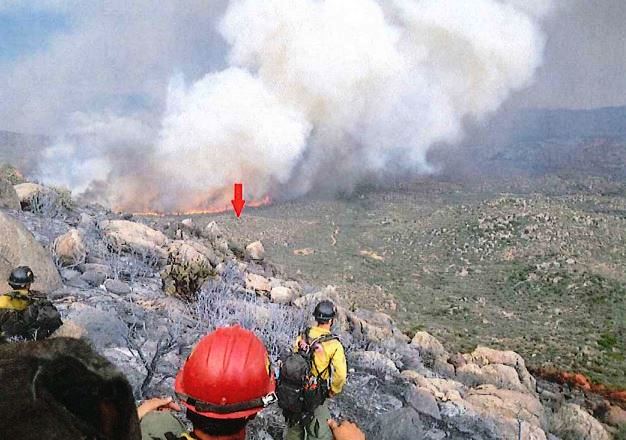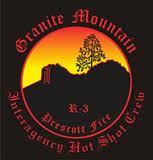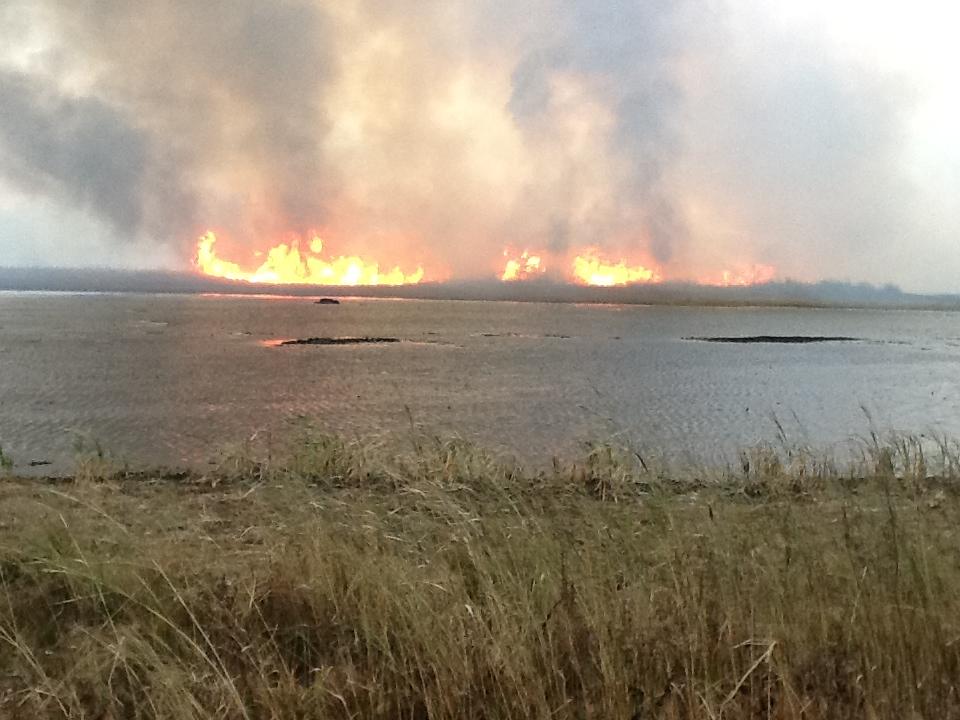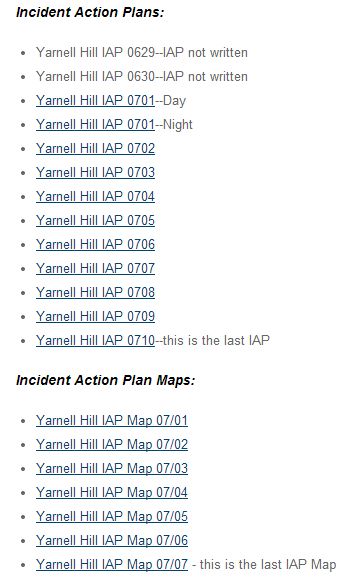
The Arizona Republic obtained a large number of documents about the Yarnell Hill Fire from the Arizona State Forestry Division which provide more insight into the management of the fire. On June 30, 19 members of the Granite Mountain Hotshots were entrapped by the fire and killed.
Notes from interviews with firefighters further confirm and flesh out some of the issues that we knew from previous reports.
The two investigations completed so far about the fire revealed little if any interaction on June 30 between the Granite Mountain Hotshots and their day to day supervisor from the Prescott Fire Department, Darrell Willis, who was not in charge of the crew on that fatal day, but was a Structure Protection Group Supervisor attempting to prevent homes from burning in Yarnell. The Arizona Republic article said there was communication between Mr. Willis and the crew that day.
Darrell Willis of the Prescott Fire Department, who helped found the Granite Mountain Hotshots, told investigators he had pressed Marsh to complete a protective fire break around Yarnell before the accident, saying, “This thing is not anchored — we got to get an anchor on this thing.” The notes say Willis “seemed to have some ‘minor guilt’” in retrospect.
“This was the last conversation he had with Eric,” investigators wrote.
From that text, it is not clear WHEN Mr. Willis “pressed” Mr. Marsh, who is normally the Superintendent of the crew but was serving as Division Supervisor in charge of the area of the fire which included the Hotshots. If Mr. Willis’ conversation with Mr. Marsh resulted in a decision to move the crew from a safe, black, previously burned area, and walk through unburned brush into a box canyon where they were overrun by the fire, this is significant news, previously unreported.
This information, interpreted by a reporter from interview notes we have not seen, makes it sound like Mr. Willis wanted the Hotshots to construct a fireline around the town of Yarnell, but under the conditions that day, it is unlikely that would have been feasible, and was certainly too big a task for one crew.
We went back and reviewed the video recordings made by John Dougherty of Mr. Willis’ press conference at the scene of the tragedy. They were uploaded to YouTube on July 23 and 24 and are in two parts, Part 1 and Part 2. Below are transcripts of portions of Part 1:
3:12: Most of this information that I’m giving you is information that I gathered based on some of the information, maps, and stuff like that. I happened to be on the fire on the north end of the fire that day doing structure protection. So I wasn’t really involved with what they were doing but we are able to monitor the radio frequencies they were on and we heard that they were gonna move out and start coming in a southerly direction based on the fire behavior.
[…]
4:32: I believe that they were, felt that they weren’t doing good where they were at, they had to abandon their tactic of trying to anchor and flank the fire and go into what we call point protection, and that’s to move fire around the houses and protect structures. I believe that that’s what their intent was and when they moved down off of there you know they’re carrying 40 or 50 pounds of tools, equipment, and a pack, upwards of 70 pounds when you put a saw, fuel and stuff on their back and they were moving down to protect this house. That’s my theory on it. Like Jim Paxton said, we’ll never know, because we don’t know what 19 of the Granite Mountain Hotshots were thinking at that time and there’s no confirmation radio traffic that we’re aware of.
At first he said he heard on the radio “that they were gonna move out and start coming in a southerly direction based on the fire behavior”. And later said, when talking about why they moved from the black to where they became entrapped, “there’s no confirmation radio traffic that we’re aware of.”
The article also reported that members of the Blue Ridge Hotshots described the aerial firefighting personnel as sounding “overwhelmed”.
Visibility over the fire area during the entrapment and the effectiveness of air tankers due to smoke has been discussed before on Wildfire Today. According to the article, an air attack person said about the entrapment:
We have a crew in trouble. We are going to go look. … It was just a sea of black. … There was too much smoke.
In discussing the predictions of the weather moving into the fire area which caused the fire to change directions and increase in intensity, a meteorologist wondered at what point, during a chaotic incident like that, does weather information need to be translated into direct decision-support actions.
Below are some excerpts from the article.
****
“A group interview with four Blue Ridge Hotshot crew members provides the first detailed account of the day they spent working near the Granite Mountain team. The U.S. Forest Service, which employs them, refused to allow them to be interviewed for the workplace-safety investigation.
In one set of notes, members of the Air Attack crew — responsible for surveillance and assistance to air tankers — told investigators they did not realize they were in charge until minutes before the fatal burn-over, when another aircraft abruptly left the fire.
The air-crew members said they weren’t sure where to make fire-retardant drops as the blaze reversed directions and bore down on Yarnell with a 2-mile- long wall of flame.
At that moment, according to the interview notes, they heard a distress call over the radio — apparently from the Granite Mountain Hotshots — and called a ground supervisor to ask, “Do we stop and go look for the crew?” The answer came back: “No, they’re safe.”
Eric Marsh, a division supervisor with the Granite Mountain squad, calmly reported that they were OK, but moments later, the crew began calling for help, and Marsh followed with an announcement that the crew was trapped and would be deploying its fire shelters. [Note from Bill: according to previous investigation reports, the “calling for help” did not come “moments later”. It was much later.]
“I looked at (another crew member), and he did this (slash across the throat),” the Air Attack flier said in the interview. “We have a crew in trouble. We are going to go look. … It was just a sea of black. … There was too much smoke.”
[…]
Throughout the interviews, key figures in the fire-suppression effort criticized almost every aspect of planning, oversight and execution.
Members of the Blue Ridge crew said they dealt with a leadership dispute among supervisors and got no instructions, records show. They characterized the overall operation as “total non-stop chaos” and “Swiss cheese” because it was so full of holes.
[…]
The Blue Ridge members said that they witnessed “a near miss” with aircraft, who they described as sounding “overwhelmed” adding that “the air show seemed troublesome.”
[…]
Keeping track of the treacherous weather conditions also proved problematic before the tragedy. Some personnel said they hadn’t received updates; others had. Chuck Maxwell, a predictive meteorologist at the Southwest Coordination Center, told investigators that as storms moved toward the fire in the early afternoon, he warned about shifting winds. Maxwell believed there was “a generally high degree of situational awareness” about the approaching thunderstorm and its impacts.
In a separate synopsis recounting June 30, however, Maxwell wrote, “Things were in relative chaos” on the Yarnell and another blaze near Kingman that was competing for resources. Maxwell said he warned that conditions in Yarnell were similar to those that led to multiple fatalities in the Dude Fire.
He questioned whether he should have personally warned firefighters to get to safety, noting that his job was to support commanders and not get in the way.
“At what point within the chaos of an incident like this,” he wrote, “does the weather information need to be translated into direct decision-support actions?” “















